By the next morning, our ship had crossed the Irish Sea and berthed in Dublin Port. We set out early with my aunt and uncle for a day trip back in time, to the royal county of Meath. Our tour began with a visit to the Hill of Tara, seat of the High Kings of Ireland. Here w
Our next stop was UNESCO World Heritage Site Brú Na Bóinne, Irish for the Palace of the Boyne, often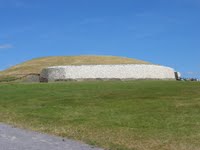 referred to as the Bend in the Boyne, more comm
referred to as the Bend in the Boyne, more comm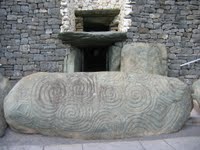 only known as the Boyne Valley. This fertile area of County Meath contains the remains of forty or so neolithic passage tombs built around 3,000 B.C., which makes them over 5,000 years old, older than the pyramids of Egypt. The enormous megalithic tombs of Newgrange (pictured), Knowth, and Dowth dominate the landscape. Mike and I had visited Newgrange twice, but this was our first visit to Knowth, where the largest number of tombs to date have been excavated. The ancient people who built them constructed the famous facade of Newgrange from white quartz they quarried fifty miles south in the Wicklow Mountains.
only known as the Boyne Valley. This fertile area of County Meath contains the remains of forty or so neolithic passage tombs built around 3,000 B.C., which makes them over 5,000 years old, older than the pyramids of Egypt. The enormous megalithic tombs of Newgrange (pictured), Knowth, and Dowth dominate the landscape. Mike and I had visited Newgrange twice, but this was our first visit to Knowth, where the largest number of tombs to date have been excavated. The ancient people who built them constructed the famous facade of Newgrange from white quartz they quarried fifty miles south in the Wicklow Mountains.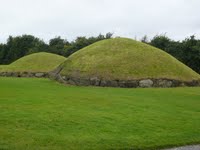
Passage tombs are found throughout Atlantic Europe, particularly in France and Brittany. They are circular mounds containing a passage and at least one chamber. The mounds are encircled by kerb stones, 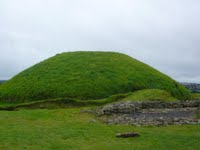 many of which display mysterious designs and carvings.
many of which display mysterious designs and carvings.
The Knowth complex lies at the western end of Brú Na Bóinne. The massive passage grave is ringed by 127 large kerb stones decorated with 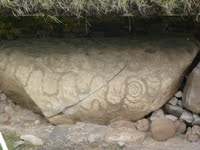 neolithic artwork. Visitors are allowed partway inside for a glimpse into history. After we enjoyed the eerie sight, we climbed to the top of the mound and
neolithic artwork. Visitors are allowed partway inside for a glimpse into history. After we enjoyed the eerie sight, we climbed to the top of the mound and 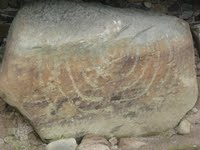 enjoyed a breathtaking view of the valley. Wondering how the area had looked 5,000 years ago and what the people who'd lived here were like, we wandered around the ancient mound and its eighteen satellite tombs until it was time to
enjoyed a breathtaking view of the valley. Wondering how the area had looked 5,000 years ago and what the people who'd lived here were like, we wandered around the ancient mound and its eighteen satellite tombs until it was time to

This comment has been removed by a blog administrator.
ReplyDeleteAwesome, Pat!! I love the pics!! Would love to visit this site!
ReplyDeleteThanks for sharing!
Wonderful pictures, Pat. You've inspired a whole new list of "things to see when I go back to Ieland," hopefully in the next few years.
ReplyDeleteGwynlyn, Nicole, and Cynthia: Thanks for "touring" with me. I enjoyed your company! The first time we visited Ireland on our own, we asked our hotel what we should see if we only had one day in Ireland. She answered without hesitating, the tombs at Newgrange. We took a Bus Eireann tour to Tara and the tombs, but it poured all day. We were so happy to have good weather for our return visit!
ReplyDeleteKathleen, in Ireland they pronounce Knowth "Nowt" (rhymes with 'snout')"All Together Nowt" "Where Are You Nowt That I Need You?" "Take a Look at me Nowt" "If I Had Shot You When I Wanted To I'd Be Out By Nowt." Thanks for the smile!
Thanks for the walk through history, Pat The pictures make me want to book a trip. I hope there is more to come.
ReplyDeleteWow Pat, these photos are incredible!
ReplyDeleteAndrea, the pictures don't do the sites justice, not by a long shot, but I'm glad to have them.
ReplyDeleteDawn, sad to say, this is the last blog for this trip, but I'm doing my best to finagle another one in the not too distant future :-)
Thanks, ladies!